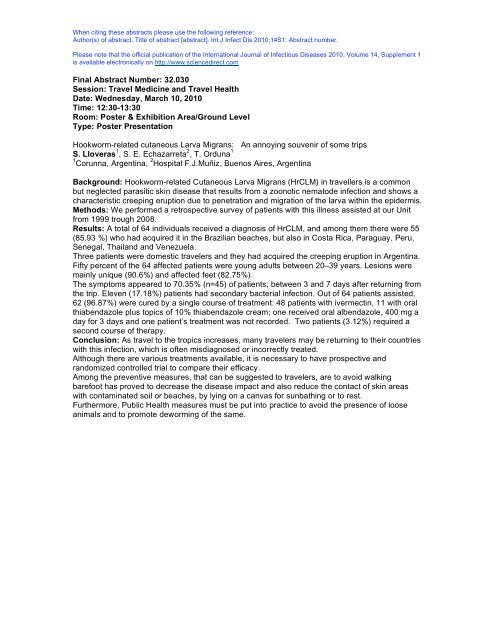14th ICID - Poster Abstracts - International Society for Infectious ...
14th ICID - Poster Abstracts - International Society for Infectious ...
14th ICID - Poster Abstracts - International Society for Infectious ...
You also want an ePaper? Increase the reach of your titles
YUMPU automatically turns print PDFs into web optimized ePapers that Google loves.
When citing these abstracts please use the following reference:<br />
Author(s) of abstract. Title of abstract [abstract]. Int J Infect Dis 2010;14S1: Abstract number.<br />
Please note that the official publication of the <strong>International</strong> Journal of <strong>Infectious</strong> Diseases 2010, Volume 14, Supplement 1<br />
is available electronically on http://www.sciencedirect.com<br />
Final Abstract Number: 32.030<br />
Session: Travel Medicine and Travel Health<br />
Date: Wednesday, March 10, 2010<br />
Time: 12:30-13:30<br />
Room: <strong>Poster</strong> & Exhibition Area/Ground Level<br />
Type: <strong>Poster</strong> Presentation<br />
Hookworm-related cutaneous Larva Migrans: An annoying souvenir of some trips<br />
S. Lloveras 1 , S. E. Echazarreta 2 , T. Orduna 1<br />
1 Corunna, Argentina, 2 Hospital F.J.Muñiz, Buenos Aires, Argentina<br />
Background: Hookworm-related Cutaneous Larva Migrans (HrCLM) in travellers is a common<br />
but neglected parasitic skin disease that results from a zoonotic nematode infection and shows a<br />
characteristic creeping eruption due to penetration and migration of the larva within the epidermis.<br />
Methods: We per<strong>for</strong>med a retrospective survey of patients with this illness assisted at our Unit<br />
from 1999 trough 2008.<br />
Results: A total of 64 individuals received a diagnosis of HrCLM, and among them there were 55<br />
(85.93 %) who had acquired it in the Brazilian beaches, but also in Costa Rica, Paraguay, Peru,<br />
Senegal, Thailand and Venezuela.<br />
Three patients were domestic travelers and they had acquired the creeping eruption in Argentina.<br />
Fifty percent of the 64 affected patients were young adults between 20–39 years. Lesions were<br />
mainly unique (90.6%) and affected feet (82.75%).<br />
The symptoms appeared to 70.35% (n=45) of patients, between 3 and 7 days after returning from<br />
the trip. Eleven (17.18%) patients had secondary bacterial infection. Out of 64 patients assisted,<br />
62 (96.87%) were cured by a single course of treatment: 48 patients with ivermectin, 11 with oral<br />
thiabendazole plus topics of 10% thiabendazole cream; one received oral albendazole, 400 mg a<br />
day <strong>for</strong> 3 days and one patient’s treatment was not recorded. Two patients (3.12%) required a<br />
second course of therapy.<br />
Conclusion: As travel to the tropics increases, many travelers may be returning to their countries<br />
with this infection, which is often misdiagnosed or incorrectly treated.<br />
Although there are various treatments available, it is necessary to have prospective and<br />
randomized controlled trial to compare their efficacy.<br />
Among the preventive measures, that can be suggested to travelers, are to avoid walking<br />
barefoot has proved to decrease the disease impact and also reduce the contact of skin areas<br />
with contaminated soil or beaches, by lying on a canvas <strong>for</strong> sunbathing or to rest.<br />
Furthermore, Public Health measures must be put into practice to avoid the presence of loose<br />
animals and to promote deworming of the same.
















